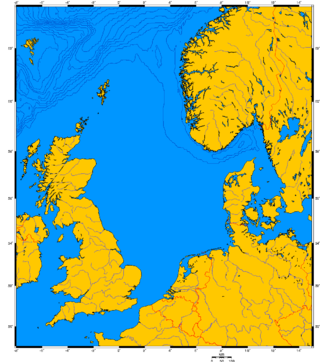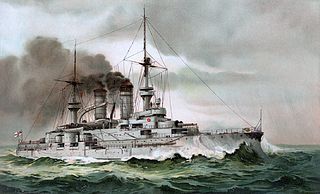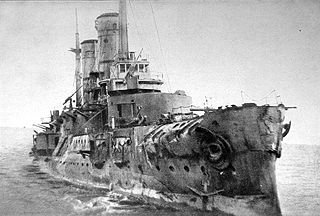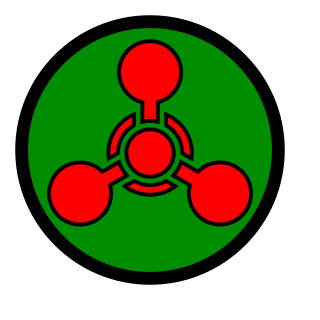Related Research Articles

The Kriegsmarine was the navy of Germany from 1935 to 1945. It superseded the Imperial German Navy of the German Empire (1871–1918) and the inter-war Reichsmarine (1919–1935) of the Weimar Republic. The Kriegsmarine was one of three official branches, along with the Heer and the Luftwaffe, of the Wehrmacht, the German armed forces from 1935 to 1945.
Mustard gas or sulfur mustard is any of several chemical compounds that contain the chemical structure SCH2CH2Cl. In the wider sense, compounds with the substituent SCH2CH2X and NCH2CH2X are known as sulfur mustards and nitrogen mustards (X = Cl, Br), respectively. Such compounds are potent alkylating agents, which can interfere with several biological processes. Also known as mustard agents, this family of compounds are infamous cytotoxic and blister agents. The name mustard gas is technically incorrect: the substances, when dispersed, are often not gases but a fine mist of liquid droplets. Mustard gases form blisters on exposed skin and in the lungs, often resulting in prolonged illness ending in death. The typical mustard gas is the organosulfur compound called bis(2-chloroethyl) sulfide.

Chemical warfare (CW) involves using the toxic properties of chemical substances as weapons. This type of warfare is distinct from nuclear warfare, biological warfare and radiological warfare, which together make up CBRN, the military acronym for chemical, biological, radiological, and nuclear, all of which are considered "weapons of mass destruction" (WMDs), a term that contrasts with conventional weapons.
Swedish iron ore was an important economic and military factor in the European theatre of World War II, as Sweden was the main contributor of iron ore to Nazi Germany. The source of iron ore for Nazi Germany 1933–43 give the following average percentages when added together: Sweden 43.0 Domestic production 28.2 France 12.9. Within the German military the Navy was most dependent on Swedish steel as an absolute necessity to the German war effort, according to their grand admiral. It has also been argued that the Swedish export helped prolong the war.

Scuttling is the deliberate sinking of a ship. Scuttling may be performed to dispose of an abandoned, old, or captured vessel, to prevent the vessel from becoming a navigation hazard, as an act of self-destruction to prevent the ship from being captured by an enemy force, as a blockship to restrict navigation through a channel or within a harbor, to provide an artificial reef for divers and marine life, or to alter the flow of rivers.

The Norwegian trench or Norwegian channel is an elongated depression in the sea floor off the southern coast of Norway. It reaches from the Stad peninsula in Sogn og Fjordane in the northwest to the Oslofjord in the southeast. The trench is between 50 and 95 kilometres wide and up to 700 metres (2,300 ft) deep. Off the Rogaland coast it is 250–300 metres (820–980 ft) deep, and its deepest point is off Arendal where it reaches 700 metres (2,300 ft) deep – an abyss compared to the average depth of the North Sea, which is about 100 metres (330 ft).

The Pine Bluff Arsenal is a United States Army installation in Jefferson County, Arkansas, about eight miles northwest of Pine Bluff and thirty miles southeast of Little Rock.

SMS Zähringen was the third Wittelsbach-class pre-dreadnought battleship of the German Imperial Navy. Laid down in 1899 at the Germaniawerft shipyard in Kiel, she was launched on 12 June 1901 and commissioned on 25 October 1902. Her sisters were Wittelsbach, Wettin, Schwaben and Mecklenburg; they were the first capital ships built under the Navy Law of 1898, brought about by Admiral Alfred von Tirpitz. The ship, named for the former royal House of Zähringen, was armed with a main battery of four 24 cm (9.4 in) guns and had a top speed of 18 knots.

The Battle of Moon Sound was a naval battle fought between the forces of the German Empire, and the then Russian Republic in the Baltic Sea during Operation Albion from 16 October 1917 until 3 November 1917 during World War I. The German intention was to destroy the Russian forces and occupy the West Estonian Archipelago. The Imperial German Navy had one battlecruiser, 10 battleships, nine light cruisers, one mine cruiser, 50 destroyers and six submarines while the Russians had only two pre-dreadnoughts, three cruisers, three gunboats, 21 destroyers, plus three British submarines.
Operation Sandcastle was a United Kingdom non-combat military operation conducted between 1955–1956. Its purpose was to dispose of chemical weapons by dumping them in the sea.

Operation CHASE was a United States Department of Defense program for the disposal of unwanted munitions at sea from May 1964 until the early 1970s. Munitions were loaded onto ships to be scuttled once they were at least 250 miles offshore. While most of the sinkings involved conventional weapons, four of them involved chemical weapons. The disposal site for the chemical weapons was a three-mile (5 km) area of the Atlantic Ocean between the coast of the U.S. state of Florida and the Bahamas. The CHASE program was preceded by the United States Army disposal of 8000 short tons of mustard and lewisite chemical warfare gas aboard the scuttled SS William C. Ralston in April 1958. These ships were sunk by having Explosive Ordnance Disposal (EOD) teams open seacocks on the ship after they arrived at the disposal site. The typical Liberty ship sank about three hours after the seacocks were opened.

Johnston Atoll Chemical Agent Disposal System (JACADS) was the U.S. Army's first chemical munitions disposal facility. It was located on Johnston Island, at Johnston Atoll and completed its mission and ceased operation in 2000.
Operation Geranium was a U.S. Army mission that dumped more than 3,000 tons of the chemical agent lewisite into the ocean off the Florida coast in 1948.
Throughout history, chemical weapons have been used as strategic weaponry to devastate the enemy in times of war. After the mass destruction created by WWI and WWII, chemical weapons have been considered to be inhumane by most nations, and governments and organizations have undertaken to locate and destroy existing chemical weapons. However, not all nations have been willing to cooperate with disclosing or demilitarizing their inventory of chemical weapons. Since the start of the worldwide efforts to destroy all existing chemical weapons, some nations and terrorist organizations have used and threatened the use of chemical weapons to leverage their position in conflict. A notable example includes the use of such weapons by the US government that sprayed more than 20 million gallons of various herbicides over Vietnam, Cambodia and Laos from 1961 to 1971. Agent Orange, which contained the deadly chemical dioxin, was the most commonly used herbicide. Other examples of the use of chemical weapons are Iraq’s Saddam Hussein on the Kurdish village Halabja in 1988 and their employment against civilian passengers of the Tokyo subway by Aum Shinrikyo in 1995. The efforts made by the United States and other chemical weapon destruction agencies intend to prevent such use, but this is a difficult and ongoing effort. Aside from the difficulties of cooperation and locating chemical weapons, the methods to destroy the weapons and to do this safely are also a challenge.

A chemical weapon (CW) is a specialized munition that uses chemicals formulated to inflict death or harm on humans. According to the Organisation for the Prohibition of Chemical Weapons (OPCW), this can be any chemical compound intended as a weapon "or its precursor that can cause death, injury, temporary incapacitation or sensory irritation through its chemical action. Munitions or other delivery devices designed to deliver chemical weapons, whether filled or unfilled, are also considered weapons themselves."

Operation Rubble in January 1941, was a British blockade running operation during the Second World War, in which five Norwegian merchant ships escaped from neutral Sweden to Britain through a Nazi German blockade of the Skagerrak, carrying valuable cargoes of specialised steel products.
The United States chemical weapons program began in 1917 during World War I with the creation of the U.S. Army's Gas Service Section and ended 73 years later in 1990 with the country's practical adoption of the Chemical Weapons Convention. Destruction of stockpiled chemical weapons began in 1985 and is still ongoing. The U.S. Army Medical Research Institute of Chemical Defense (USAMRICD), at Aberdeen Proving Ground, Maryland, continues to operate.

SMS V190 was a S-138-class large torpedo boat of the Imperial German Navy. She was built by the AG Vulcan shipyard at Stettin between 1910 and 1911, completing on 5 August 1911.
References
- Kassim, Tarek A. and Barceló, Damià. Environmental Consequences of War and Aftermath, (Google Books link), Springer, 2009, p. 9, ( ISBN 3540879617).